Tech Talk: When oil isn’t crude and gas isn’t gas, the Eagle Ford Shale play
Posted by Heading Out on December 19, 2010 - 9:05am
There are two figures that keep cropping up when folk write about the production of oil, one number is the daily flow rate for crude oil, and while the EIA report that the peak production year to date was in 2005, when the world produced 73.72 mbd, the IEA have reported that the peak occurred in 2006. Yet just last week the IEA raised their forecast for next year’s oil demand to 88.8 mbd and there is about 15 mbd difference between the two numbers. So you might ask what causes this, where do these additional liquids come from and what is their future, relative to that of crude alone.
Part of the answer comes from what are known as refinery gains, the fact that when you crack a high-carbon crude into lower carbon products in a refinery then there is a gain in volume. In Oil 101 Morgan gives this processing gain in volume to be around 2.2 mbd. In addition there is the rising level of bio-fuel production, about 900,000 bd of ethanol in the US alone, for example. But the largest volume comes from the liquids associated with the production of natural gas.
These are collectively described as Natural Gas Liquids (NGL) and condensate. Simplistically, when natural gas comes out of the reservoir it is not always what is referred to as a dry gas, but rather can often contain a number of other constituents in the fluid flow. The NGLs are normally a combination of ethane, butane, isobutene, propane and natural gasoline and are normally combined with other light hydrocarbons that condense out of the fluid flow at the surface, when pressures and temperatures fall from those in the reservoir. These additional fluids are the ones generally called condensates, as a result. (The NGL's need a little pressure to re-liquefy). NGL total volume is about 8 mbd. Now to make life somewhat more complicated both oil and gas can come out of the same well at the same time in an admix that can include all of the above. And that requires that they be separated, but that is a topic for another day or two. Today I want to give an example of the importance of those liquids that lie between crude and natural gas.
These mixtures can be more important, depending on the relative composition of the flows that are then obtained. Consider, for example, the Eagle Ford shale, the new field that is being developed in Texas, where wells that are to be drilled into the gas shale are now touted for their liquids content, rather than for the natural gas that they are more commonly anticipated to produce. When the field was first drilled, back in 2008, the initial well flowed with natural gas production of 7.6 million cf/d and there have been some 944 permits for wells as and of last week.
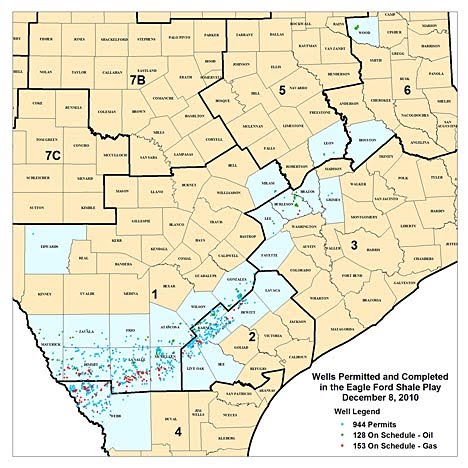
However it is not just the surface location of the wells that has to be considered. And if those of you with more knowledge will forgive the repetition, I need to just give a short paragraph of explanation about where oil and gas originally came from. Very simplistically they come from algae that flourished in the oceans of the time, somewhere between 65 and 500 million years ago. The algae contained some lipids (an oil precursor) as do those of today. As the algae died their bodies fell to the seabed where they accumulated in layers, along with the sediment that collected with them. Over time that nascent rock was buried deeper in the Earth’s crust and as it did the pressure and heat slowly changed the lipids, initially into oil. However if the rock was carried deeper, then the oil was further cooked and became natural gas. The process has been illustrated at the oil and gas geology website where I got this illustration:
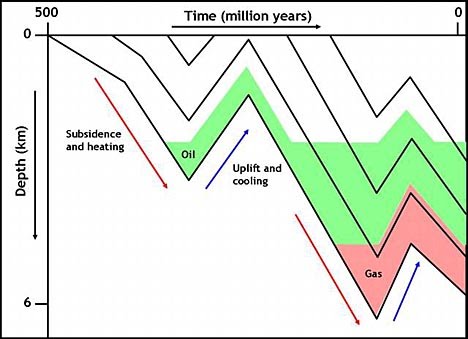
As a rough rule of thumb down to 15,000 ft the hydrocarbon is more likely to be oil, (which is thus referred to as the Oil Window) and below that it is more likely to be gas. That is only a rough rule of thumb, and one must remember that over time there has been a lot of uplifting and eroding, so that 15,000 ft isn’t necessarily what it used to be.
And the Eagle Ford shale is a fairly good example of this. If we use the EIA map of the play you can see that in the North, where the reservoir is about 6,000 ft deep the hydrocarbon is oil, while further South, where the deposit is down at around 14,000 ft then the hydrocarbon is dry gas. And in between it is what is known as a wet gas.
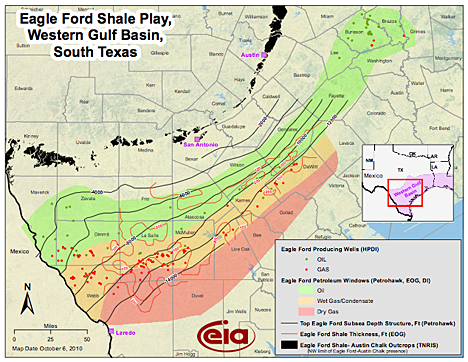
You will also see that the majority of the wells are in the wet gas/condensate section of the field. As a result, when we look at the amount of the different fluids that have come from the field in the two years of major production to date, we get the following plot. And to make it, I have made the simple assumption that 6,000 cubic ft of natural gas is equivalent to a barrel of oil (which I call the Apache number )

You may note that the condensate from the wells in the wet gas zone have produced around 2.3 million barrels, while there has only been about 1.6 million barrels of crude produced. It is also worth noting that while the natural gas coming from the formation has been twice the equivalent volume of oil, the market for natural gas, at the moment is still down at around $4.6 per kcf, which using the Apache conversion, would give it a price of around $27.60 a barrel of oil equivalent. On the other hand the condensate is a light high quality product, and West Texas Intermediate crude is running at the moment at around $88.30 a barrel. (EIA last Natural Gas Weekly.) You should also remember that these are not the retail price for the products – natural gas in Florida, for example, was given as $10.56 per kcf, while it is around $9.81 in New York (ibid).
The current excess of natural gas supply over demand, which is likely to continue through at least next year (and which I will discuss in more detail in a number of future posts) will likely keep the price of natural gas down around the $4 figure through most of next year. On the other hand the increasing demand for oil when set against the limited ability of the industry to respond, will likely mean that oil may well move over $100 a barrel.
So now you know why they are drilling in the middle of the play known as the Eagle Ford Shale.
After I had written this piece Art Berman was gracious enough to add a couple of comments and two useful maps to the post, which I am delighted to append. He commented:
The role of NGLs, refinery gain, and ethanol in the oil balance are very distracting and make it seem that we have a lot more liquid fuel stock than we really do. I do not much like the EIA fluid map or the Apache number because a 6:1 BTU conversion has a poor relationship to the economics of the liquids. I will send some recent maps that I made based on current production using a 16:1 conversion based on price. In this view, most wells are in a relatively "liquids-lean" part of the play."
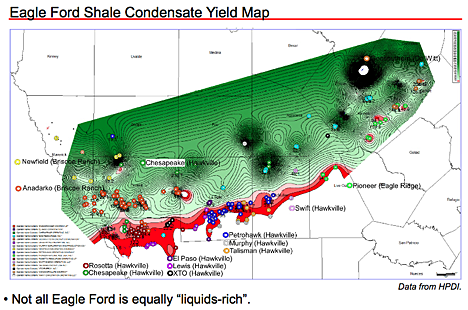
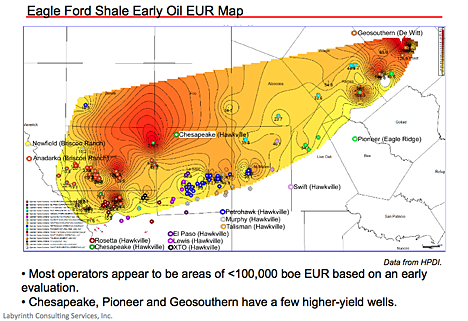
Thanks, Art.




For those who haven't read it in the previous posts:
20/9/2010
IEA corrects oil statistics containing bio fuels
http://www.crudeoilpeak.com/?p=1876
13/4/2010
Natural gas liquids and other liquids mitigate crude oil peak
http://www.crudeoilpeak.com/?p=1352
Your oil-money at work for a very special X'mas tree:
http://www.arabianbusiness.com/photos/emirates-palace-unveils-11m-christ...
Matt,
OT, but your last link above reminded me of this.
http://ireport.cnn.com/docs/DOC-508976
a conversion based on heating value or price is equally useless, unless you have an application which can utilize either.
using boe's for economic calculations, which i think is what berman is doing, opens a whole other can of worms of uncertainty.
Fuel consumption of Honda Civic GX vs regular Honda Civic might be a good basis for comparison
Thanks HO for continuing this series.
I went back and re-read the two earlier posts to which you linked (GOSPs) and wonder: Do you (or does anyone here) know (1) how many GOSPs serve the Eagle Ford, (2) typical dimensions (diameter, length) of lines that connect wells to GOSPs, (3) costs to build and connect a typical GOSP?
H.O. Another very good explaination of our energy production.
The Eagle Ford shale is producing only about 10,000 b/day in 2010. What is the expected C + C production level at peak? How much will full development of the E F offset natural decline of mature fields in Texas?
Don't know about any total numbers, but one company is planning a pipeline with a capacity of 120K bpd, and the possibility of increasing to 200K bpd that would exclusively serve the Eagle Ford shale. I would presume that's only part of the picture.
I have questions about the future availability of bottled gas (propane). Having traveled some in developing countries and living in a rural area without NG availability, I feel that the future availability of propane will be of increasing importance due to its portability and storability. The good news is that it seems to be fairly abundant in shale gas plays and wet wells.
Will these NGLs be diverted more into other uses as other liquids production declines? I haven't seen the future of propane discussed much here. Any comments would be appreciated. Propane is a small, though very useful part of my energy mix.
Propane actually gets its own page on the EIA This Week in Petroleum page, and so far this year there don't appear to be any problems developing. Almost all the demand appears to be met domestically.
If the availability of LPG cylinders was to decline in this part of Mexico, and I suspect most parts of the rest of the country and Latin America, there would be severe results especially if it was felt to be due to being transformed into gasoline for use in cars. It is a VERY integral part of the food cycle here. The staple food is the tortilla, the masa cooked with gas, the tortilla cooked with gas and the taco filling cooked with gas. The amount of tortillas consumed by a family, every day, is measured in kilograms. Trying to buy less than 1/2 a kilo at a time gets strange looks. To change this dependence would be harder than jemmying Americans out of their SUVs.
NAOM
I remember a propane shortage that hit Mexico (1996?), that drove prices up substantially in the US. A buddy working in Nogales said that the situation caused fighting and near riots in the area.
While we do well off-grid, we use propane for cooking and I don't relish the idea of cooking with wood. While we keep our big tank fairly full for the clothes dryer and backup hot water, I have a couple of 100# cyliders in storage. One of these would allow us to cook for a long time in case of a shortage.
Propane seems like the 'red headed stepchild' to NG. Increasing its use for transportation would be a bad play IMO.
Ghung, I also live off-grid and utilize some propane for cooking, mostly in the summer when it's too hot to cook with wood, although I do have a wood cook range installed out on the front porch for warm weather oven things. It doesn't get used much because I also have a solar oven which fills the bill in summer. Propane use is around 10 gallons per year (2 5 gallon bottles, rotated). Why use any energy other than sun & wind to dry your clothes? I hang the wet laundry on racks indoors year-round, usually dries overnight. Water heating is with a copper coil run through the woodstove chimney then thermo-siphoning hot water into a tank mounted next to & above the stove. This provides abundant hot water year-round with a morning fire for cooking & making coffee, tea. Better to store extra firewood than extra propane, it looks nicer, gives a more secure feeling...
"Why use any energy other than sun & wind to dry your clothes?"
I have a wife ;-) (though we do have a clothes line and drying rack that get used alot). Cooking with wood is something I hope to delay ALAP.
We also heat water with wood and solar; propane is a backup that was required by code for DHW and radiant floor. I have a small wood cooking stove that will likely get used in the future. Building a solar oven is on my list, though our (solar powered) microwave gets used alot. I built a screened porch that was designed to be a summer kitchen; used now for smoking and canning. Large propane tank is buried; out of sight for asthetics and security.
The mating rituals and nesting habits of the human species account for the majority of energy expenditures.
You forgot to mention gold.
We have nice green hills around here. If cooking was forced to wood it would not be long before those hills would be stripped bare. When the rains come there would be flooding and landslides. The results would not be pleasant. I've been playing with a little solar cooking but this has interested someone else. I may look at this a bit harder in the new year.
NAOM
In some parts of India, gobar gas has been adopted with some enthusiasm. Any chance it might catch on in Mexico?
How would it be transported? Liquid is a no, you would need a lot of pressure for tanks and a pipe grid is a lot of new infrastructure prone to thieves (see recent oil explosion), erosion, earthquakes, JCBs etc.
NAOM
You don't transport it. Each home has a gobar-gas generator. Getting rid of the nutrients which feed fly larvae improves the public-health situation in the absence of sewer systems, and it requires no electric power to run either.
That might work for rural but the houses in towns do not have free land. How would those manage?
NAOM
That's a good question. They work just fine in holes in the ground, so I suppose it's a possibility to put them below grade or even sub-floor indoors. People tend to be very creative, and it only takes one good example to create a lot of followers.
The point is that the gas supply is free once the generator is built, so if cooking over it isn't too different it may find acceptance very quickly.
That then begs the question of safety related to methane leakage. Poor construction, a perpetual hazard around here, and earth movement, earthquake plus seasonal wet/dry heave, can impact integrity. Seasonal saturation of the soil could flood the system, we have many areas built on reclaimed swamp with wet soil.
I'm not having a poke at the idea but trying to look at the realities of the installation. So far I am seeing it as a system that may work well in some areas/communities but the problems may ought weigh the utility in others. This may help take some capacity away from LPG but I have doubts about it being useful as a universal panacea. Maybe it needs a 'more work to be done tag'.
NAOM
Methane is only a simple asphyxiant, though explosion hazard is a factor if a leak produces concentrations over 5%. As bio-gas, it will have a large admixture of CO2 which will both reduce the flammability and create immediate reactions to breathing it.
I'm sure nothing is universal. However, measured against things like the contribution of leaking LPG systems to the smog in Mexico City (methane is not reactive in smog), it probably deserves a lot of attention.
Coming from the UK it is the bang potential I would be concerned about. The UK regularly blows up houses. There was one recently and look up "Ronan Point" for an example of how bad it can get. There have even been gas explosions in houses not connected to gas from leaks in the street pipes. I don't know how much LPG contributes to the smog in Ciudad but the traffic must be one of the leading factors. Interestingly Gudalajara is putting 2 hybrid buses on the streets to test.
NAOM
The USA has gas explosions too, but a house in a tropical climate (probably very well-ventilated) with a very limited supply of gas is going to be at rather low risk for that.
On a gas plant that I helped design, the liquids dropped out in the pipeline and collected there. Periodically a pig is run down the line to push the liquids to the slug catcher. Slug catches are upstream of the gas plant. The purpose of a slug catcher is to remove the liquids from the gas. The liquids go to a storage tank and are trucked to another site for use. The gas goes to the gas plant to separate propane, ethane, butane, etc. I was responsible for the purchase of a “harp” type slug catcher that was as long as a football field. Taylor Forge probable will have a picture of a harp type slug catcher on their site. There are many variations to knock the fluid from the gas.
http://www.tfes.com/slugCatcher04.htm
NAOM
Oh boy, here we go again. There are many such geological processes that people seem to just accept as being true regardless of the fact that such a process is not even possible due to a simple problem of scale. I often use salt as an example. I ask someone where does all the salt in the oceans come from. Of course they say erosion over billions of years. I tell them first of all the oceans are only 65-200 million years old. Then I say that if you take all the salt out of all the oceans and cover the land with it, the entire earth's land mass would be covered in 400 feet of salt. It's a pretty simple mathematical proof. Yet the conclusion that must be drawn from that proof is not so easily reached. But nonetheless it is obvious that so much salt certainly did not come from erosion. It is simply not possible. That is the problem of scale. When you know something cannot possibly be true based simply on the sheer magnitude of the quantity involved. What is possible is based on actual evidence, such as the fact that both hydrochloric acid and ammonia have been found to be leaking out of mid ocean rifts. So there you have pretty damn conclusive evidence of where most of the world's salt comes from. Again I'd say it's pretty obvious, an open and shut case.
This kerogen / decaying lifeform / dead dinosaurs thesis has been touted and parroted for decades now and it sickens me to see it so blindly accepted despite the fact that it too is not tenable and also falls victim to the same problem of scale. If you actually believe in that nonsensical theory then the question you need to ask yourself is "how much kerogen can a ton of decaying life produce?"
And that leads to: "how much petroleum can a ton of decaying life produce?" And when you actually do try to make some educated guesses, you end up with a number that makes 400 feet of salt seem perfectly reasonable. It's just not possible. All the life that ever existed on earth could not possibly make up even 1% of the amount of biomass required to produce the precursors for even one year's supply of oil. Not to mention there is no evidence whatsoever that dead rotting life even gets buried on such a scale to even begin to explain this process. And even if there was, how does it get buried beneath cap rocks that have been measured to be older than the oceans from which all this source biomass supposedly came from? Again, another case of simply not possible and absurd on its face. There is actually more evidence that the earth is flat than there is evidence supporting this absurd mindless mainstream theory about where oil comes from.
What is the point in discussing peak oil if the most basic assertions of "modern" geology are incorrect?
I ask someone where does all the salt in the oceans come from. Of course they say erosion over billions of years. I tell them first of all the oceans are only 65-200 million years old.
What planet are you living on? On the planet the rest of us are living on, the water in the oceans (not the oceans we have now, but ones similar to them) is approximately 4 billion years old. The ocean floors are no more than 200 million years old, but that's because they have been recycled by plate tectonics.
This kerogen / decaying lifeform / dead dinosaurs thesis has been touted and parroted for decades now ... you need to ask yourself is "how much kerogen can a ton of decaying life produce?"
None. In general, kerogen was produced after plankton matter settled into the mud under anaerobic conditions where it did not decay. There are very few dead dinosaurs in it because, except in rare instances, dead dinosaurs did not sink to the ocean floor under any kind of conditions. They were land animals
And that leads to: "how much petroleum can a ton of decaying life produce?" And when you actually do try to make some educated guesses, you end up with a number that makes 400 feet of salt seem perfectly reasonable. It's just not possible. All the life that ever existed on earth could not possibly make up even 1% of the amount of biomass required to produce the precursors for even one year's supply of oil.
It's a big old planet. There are places where the salt deposits are miles thick. And, more to the point, there are places where there are miles of organic rock, and it is still being formed. One such place is the Gulf of Mexico, where the Mississippi River and older rivers that preceeded it have deposited miles of sediment. Oil is still being formed in the GOM - some of it is less that 1000 years old.
What is the point in discussing peak oil if the most basic assertions of "modern" geology are incorrect?
Well, for one thing, how the oil was created is irrelevant to the peak oil theory. What is relevant is how it is being used up.
Rocky - Talk about dangling red meat in front of a hungry tiger. Glad you took the time to respond. I'm trying to button things up at the office while I'm preparing for my knee surgery tomorrow. Nope...not from running up and down rigs for 35 years. Just got freakin' old. LOL
Well, somebody has to dangle raw meat in front of the tiger. Otherwise the tiger begins to think he is king of the jungle. (I'm just thinking back to the extinction of the saber-toothed cat. He probably thought he was at the top of the food chain, too.)
I have a couple of joint replacements coming up in the forseeable future, too. I didn't wear them out running up and down rigs. Most likely it was the Rockies, the Alps, the Andes, and the Himalayas that did them in.
Particularly the Himalayas - you think the Rockies are big until you see the Andes, and then you think the Andes are big until you see the Himalayas. And then you try to hike across them and discover the limitations of the human body.
Hi Rockman,
Sorry to be so off topic, but I couldn't resist commenting on your knee surgery. I've had total replacements of both knees (and minor surgery on both earlier). If you are NOT getting total replacements, the surgery is no big deal. However, for total replacements to be successful you MUST take the rehab very seriously. You can count on one month of misery followed by 2 more months of aggravation (sorry). But, it's worth it - my first replacement does not complain when riding my bike 80 miles a day. I'm 6 weeks into my second replacement and fully expect to be doing 80 mile days next summer. Best wishes and hang in there with the PT. PS: I always appreciate your comments.
Good for you Dave. I actually had my miniscus sewn up on both knees at the same time about 16 months ago. Needed to get fixed fast before I started a new gig. Uncomfortable but didn't have a choice. Unfortunately the right one did last long. Almost pushed for a full replacement but went with one more repair. Been amazed how many folks are getting one joint or another replaced these days. Fortunately I spend most of my days in front of a computer. And extra thanks for real time satelite links. I just checked on one of drilling wells from my living room. I can monitor all the rig hydraulics as well as the log-while-drilling data. Even when I do go to the drill sites I'll spend most of the time sitting in my car observing the ops and communicating with the office thru an air card.
Just for kicks, I did a quick sanity check on one of iconoclast421’s assertions – that all the life that ever existed on earth could not collectively account for even 1% of the biomass needed to produce the precursors for 1 year’s supply of oil.
1. 1 year’s supply of oil = 31 billion barrels = 9.7 trillion pounds of oil (i.e., 10 raised to the power 12)
2. One estimate of the biomass on earth at this particular instant in time = 560 billion tonnes = 1.2 quadrillion pounds (i.e, 10 raised to the power 15!)
( http://en.wikipedia.org/wiki/Biomass_(ecology) )
Now that’s just the biomass at one particular instant in time. Take this number and stretch it out a couple of billion years and it seems you get enough accumulated biomass to cover all the oil quite nicely. Big old planet indeed!
With apologies in advance to the Lab Lemming, I quoth:
From Can whales solve the oil crisis?.
However the original whale population is believed to be drastically underestimated. Researchers have been going through old whaling records and have calculated that the pre-whaling population was many times the size of previous estimates. This has a severe impact on the calculations for breeding and replenishment rates indicating that the cycle is much longer and slower than previously believed. This is supported by finds of very old harpoon heads in some whales. Given that the whale would have needed to be sufficiently large, read old, to be a good whaling prospect it seems that whale lifespans are considerably longer than previously thought, maybe 200-300 years. Again this points to a slower replacement rate.
NAOM
That's a little too simplistic. Most of the oil originates as plankton, either phytoplankton (plants) or zooplankton (animals). All algae are plankton, but not all plankton are algae.
The plankton settled to the sea floor and were buried in the mud under anaerobic conditions where they did not decay. This formed an organic mud which eventually turned into an oil shale. That was the origin of vast US deposits of oil shale. However, oil shale does not really contain oil, it contains kerogen, which is an oil precursor.
If oil shale is buried deep enough, heat and pressure will turn the kerogen into crude oil. Failing that, companies can convert it to synthetic oil at the surface by heating the shale to a high enough temperature. However if it gets buried too deep, the excessive heat will convert it to natural gas instead of oil.
That's probably enough Oil 101 for now.
Iconoclast has also overlooked the fact that there is no sodium in either HCl or ammonia, so his theory of the origins of salt leaves a bit to be desired.
I'm disappointed, I wanted to hear more from Iconoclast concerning abiotic oil that he had just "learned" about from the fictional best seller, The Emperor's Tomb
Oops:
Some algae are planktonic, some are benthic, and, with appropriate hallucinogens, some may appear to be nektonic.
We, may, however, be digressing.